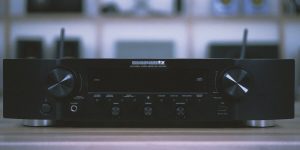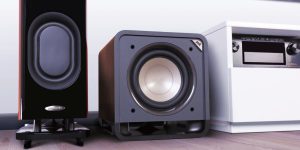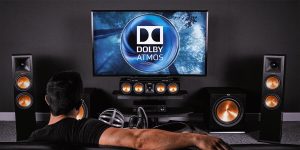There are quite a few home theater receivers on the market today. Modern models offer not only basic functions but also advanced opportunities such as multi-room, voice control, support for streaming audio platforms, etc. Nowadays, multi-room is the most popular among users. Therefore, I have conducted a lot of tests and selected the best 3 zone receivers for you that are really worthy of your attention.

Which device you need depends a lot on your requirements and capabilities. And since each brand tries to surprise the buyer in its own way, offering different benefits, I decided not to dwell on any one company. But before I get to the prepared reviews, let’s first look at what features three-zone AV receivers provide.
| Name | Channels | Power output | HDMI in/out | Bluetooth/Wi-Fi | Review |
|---|---|---|---|---|---|
| Marantz SR7015 best overall | 7.2 | 125W/8 Ohm, 235W/6 Ohm | 8/3 | yes/yes | Review |
| Onkyo TX-NR7100 budget | 9.2 | 100W/8 Ohm, 220W/6 Ohm | 7/2 | yes/yes | Review |
| Denon AVR-X4800H | 9.4 | 125W/8 Ohm, 165W/6 Ohm | 7/3 | yes/yes | Review |
| Yamaha RX-A6A | 9.2 | 150W/8 Ohm | 7/3 | yes/yes | Review |
How does 3 zone receiver work?
Thanks to a device that supports multi-room functionality, you can play different audio and video content in three rooms simultaneously. How does it work? Once the receiver has received the signal from the sources, the unit splits it up and directs it to different places, whether in the kitchen, bedroom, or so on. Also, if necessary, you can use two zones in the same room to get a higher-quality two-channel stereo power amplifier and audio-only speakers.
I want to tell you right away: you will not find a 7-channel receiver with 3 zones. So, if you want to use three multi-room zones, you must consider buying a 9- or 11-channel receiver. As for my review, all models have a 9-channel amplifier.
Best 3 zone receiver reviews
Marantz SR7015 – best overall
The Marantz company is considered one of the leaders in the receiver manufacturing industry. Their products have many fans around the world. However, the modern market is filled with various exciting models of this brand, and it can be challenging to choose. That is why I have prepared the Marantz SR7015 review for today. It is IMAX Enhanced certified, supporting Auro-3D's proprietary immersive audio technology, enhanced by the Auro-Matic mixer that delivers three-layer sound, including standard surround, ceiling, and height speakers. This technology makes Marantz's immersive sound stand out from many competitors.
Another famous Marantz technology allowing this company to compete with Denon successfully is HDAM (Hyper Dynamic Amplifier Module). It is used on top-level AV receivers, such as the SR7015, and focuses on noise reduction. Therefore, providing accurate, clear, and detailed sound while still making it feel dynamic, the SR7015, in some cases, outperforms even the mighty Denon AVR-X8500HA.
Design

Like other receivers from the product line, the SR7015 offers a classic design consistent with the company traditions. Curvy sides somewhat distinguish it from other AV receivers from other brands. There is a huge power button supplemented by input controls on the left. The right side offers a large volume control dial. The display between these dials shows only the bare minimum information. It's not bad, and besides, Marantz has always been famous for its desire for minimalism and ergonomics.
From the first touch, the unit feels rigid and well-developed. All elements (even the smallest ones) and components look solid and of high quality. However, in terms of size and weight, it is not distinctive from other receivers from the same price range. The unit's dimensions are LxWxH 16.54 x 17.32 x 7.48 inches, and it's a bit heavier than 30 lb. The SR7015 comes in two colors: silver-gold and black.
Features and specs

The Marantz SR7015 is a 9.2-channel AV receiver. According to the SR7015 specifications, it offers 125W power per channel with 8 Ohms speakers with 20Hz-kHz 0.08% THD. When using 6 Ohms speakers, it provides 165W 1 kHz with 0.7% THD. The AK4458 chip is a central audio processor in this receiver which guarantees a quality sound without interference. An interesting aspect is that the audio processor can support up to 11 channels, but the receiver has only 9 built-in amplifiers. So it may need an additional amplifier to show its potential entirely.
The SR7050 has a rich set of inputs, including 8 HDMI (1 front) support HDCP 2.3. Sadly, only a single HDMI input supports 2.1. Other inputs include a single USB, 4 composite videos (1 front), 7 line RCAs, 2 coax, and 2 digital optical and 6 analog inputs (1 front). Outputs include 3 HDMI (1 supports eARC), and a single HDMI supports 8K/60Hz and 4K/120Hz. Other ports include Ethernet, remote control, FM/AM antenna, and RS-232C port. The unit is equipped with 2-band Wi-FI and Bluetooth and supports the AirPlay2 function. Also, the receiver supports Deezer, TuneIn, Spotify Connect, TIDAL, Amazon Music, and Amazon Alexa voice assistant. In my opinion, this model's range of features and versatility is clearly above average.
Just like older receivers had to come with built-in support of radio features, modern receivers must support Zone 2. The SR7015 pleasantly surprises by allowing the arrangement of three separate audio rooms as it supports Zone 2 and Zone 3. Also, the model has access to the HEOS ecosystem, which allows for organizing a multi-room setup and managing all the devices through a single application transferring data between HEOS-compatible systems.
This model supports 8K 60 Hz video, including 8K upscaling, with support for HDR options: HDR10+, Dolby Vision, Dynamic HDR, HLG, and HDR10. Also, the receiver supports Quick Frame Transport (QFT) technology and automatic low latency operation mode (ALLM). Furthermore, Marantz SR7015 features all modern immersive sound formats, including DTS: X and Dolby Atmos, Auro-3D, and even DTS Virtual. Quite a profound set of features. Indeed, I was wondering how it sounds. Therefore, next, I will share my experience testing the sound of the SR7015.
Listening experience

First, I will share how the SR7050 handles surround sound when watching movies. My BP9080X accompanied the receiver to let it show its full strength. The unit provided an incredible bass, filling the room with immersive vibes. It even made my clothes vibrate during active moments. I have to admit a pleasant balance between action scenes and calm moments. In addition, the receiver managed to keep readable dialogues delivering the slightest details. Overall, it left a very positive experience, completely satisfying my needs. I can't wait to get my hands on Avengers 5: The Kang Dynasty to watch with the SR7050.
While music is not the main selling feature for the AV receiver, Marantz SR7050 showed itself very well, keeping a consistent quality and sound distribution. Indeed, a dedicated pre and power amplifier for the same price would deliver a superior and more energetic sound. But concerning its excellent immersive sound in gaming and watching movies, it is a very solid solution worth every cent you pay for it.
Key specs
- Channels: 7.2.
- Power output: 125W/8 Ohm, 235W/6 Ohm.
- HDMI inputs/outputs: 8/3.
- Video functions: 8K/60Hz, 4K/120Hz, 4K/60Hz pass-through, video upconversion (up to 1080p and 8K) for analog and HDMI sources.
- Bluetooth/Wi-Fi: yes/yes.
- Streaming services: AirPlay 2, Pandora, Spotify, Napster, SiriusXM, TIDAL, Deezer, Qobuz, Amazon Music.
- Suppots: HDCP2.3, HDMI ARC, HDMI eARC, Dolby Vision, CEC, HLG, HDR, HDR 10+.
- Surround sound: DTS HD Master, Dolby Atmos, Dolby Atmos Height Virtualization, Dolby TrueHD, Dolby Surround, DTS:X, DTS Neural:X, Multichannel Stereo, Auro 3D, IMAX Enhanced.
Summarizing the above, I can conclude that the Marantz SR7015 is indeed the best 3-zone receiver. Quality components and assembly, excellent sound and video capabilities, only confirm my conclusion. And the presence of 3 multi-room zones is the key to turning your home into a real multimedia center.
Onkyo TX-NR7100 – budget
Onkyo is a manufacturing company originating in Japan. Despite its long history in making audio equipment and some of its popular home theater systems, most people still prefer to stick to Denon, Marantz, and Yamaha. I didn't hesitate to make the Onkyo TX-NR7100 review when I had the chance, even though this brand is somewhat out of earshot for most people. One can translate the company's name from Japanese as "harmony of sound." It resembles their main goal - making reliable sound equipment to feel our homes with sound and harmony.
Those interested in the industry probably already heard about their TX-SR393 receiver when the company tried to take the lower price segment of the market or their mid-range TX-NR696. In turn, the specification of this 9.2 channel is pretty optimistic, especially considering the price range and that the unit is full of modern technologies. So, I want to see how Onkyo tries to cut a slice for themselves of the AV receiver market pie.
Design

Looks and design are indeed subject to personal opinion. Too much depends on the individual taste, yet, Onkyo offers a true refreshment after the Denon AVR series and Marantz with their NR receivers. The TX-NR7100 offers versatility, having only one colossal volume control surface on the right side. On the left, it has two smaller knobs and several control buttons. It resembles classic receivers from the 90s - a traditional black box with multiple control buttons and several inputs.
From the ergonomic perspective, such a location is neither better nor worse than its competitors. All the difference lies in personal preferences, whether the control buttons should be located and how their color and display match the overall setup. The dimensions are also pretty standard for this class - 17-3/16"W x 6-13/16"H x 16-3/16"D. The same can be said about its weight - 22.9 lbs, which is a bit heavier than the AVR-X1700H from Denon.
Features and specs

Onkyo TX-NR7100 offers 100 watts per channel with 8-ohm speakers at a classic 20-20.000 Hz rate with 0.08% THD, which is pretty standard for this price range. It was enough to provide a pleasant sound with my 5.4.4 setup, with no distortions or feelings of a lack of power. Regarding channels, the TX-NR7100 has a clear advantage over Denon AVR - X2700H and can be compared to the AVR-X3700H.
According to TX-NR7100 specifications, the receiver has 7 HDMI inputs, yet only the main one supports eArc/Arc. The number of HDMI outputs equals Denon AVR-X2700H and Marantz SR5015, which have 2. The unit includes component and composite video inputs, single phono, and two digital inputs. Altogether, this set of connectors allows the receiver to handle almost any device connected to it. It also has Bluetooth, Wi-Fi, and AirPlay 2 built-in, together with supporting current streaming services. Furthermore, the receiver supports Zone 3 feature, which is not very common in this price range.
Onkyo TX-NR7100 features the latest sound enhancement technologies, including DTS Neo:X, DTS:X, and IMAX Enhanced. The main HDMI inputs can support up to 8k/59-60HZ video, supplemented by HDR10+ family technology. At 4k resolution, one can watch movies or play games at 120hz. While in gaming, the receiver shows itself more or less equally to main competitors. It has a clear advantage over the AVR 2700H and SR5015 when watching movies as it is IMAX Enhanced, surpassing them in terms of picture, sound, and scale.
Like other AV receiver companies, Onkyo has its own room equalization and calibration technology - Accu-EQ. For those users who have no experience in tuning the receiver by themselves, this technology will seriously help. Indeed, a professional will tune the receiver much better, but Accu-EQ also does an excellent job.
Listening experience

Concerning the price and support of the 9.2 channel, I was eager to put the receiver to the test with movies. I chose several more or less modern ones and undying classics to check the upscaling. I can't say the receiver takes the sound quality to the next level, but it has clear advantages over competitors. While supporting the same new surround audio sound formats and video technologies, it is IMAX Enhanced, which adds lots of quality to sound and pictures. Loved the bass parts and grainless dynamic moments.
The receiver fades when listening to music, offering no advantages over Denon AVR X1700H or Marantz NR5015. I can't say it sounded bad, yet I missed overtones usually inherent to Denon, Marantz, or Yamaha, considering their unique sound. Overall, the receiver shows itself to be very solid. I never felt like an Onkyo fanboy or even had any faith in it, yet, concerning the price, the TX-NR7100 is an excellent receiver that can genuinely compete with its rivals. Maybe if Onkyo had more models like the TXNR-7100, we would have heard more often about this company.
Key specs
- Channels: 9.2.
- Power output: 100W/8 Ohm, 220W/6 Ohm.
- HDMI inputs/outputs: 7/2.
- Video functions: 8K/60Hz, 4K/120Hz, 4K/60Hz pass-through, video upconversion (up to 1080p and 8K) for analog and HDMI sources.
- Bluetooth/Wi-Fi: yes/yes.
- Streaming services: AirPlay2, Deezer, Tidal, Pandora, SiriusXM, Napster, SoundCloud, Amazon Music, Amazon Music HD, Mood mix.
- Supports: HDMI ARC, HDMI eARC, HDMI CEC, HDCP2.3, HDR10, HDR10+, Dolby Vision.
- Surround sound: DTS HD Master, DTS Neural:X, Dolby TrueHD, Dolby Surround, Dolby Digital Plus, Dolby Atmos Height Virtualization, Dolby Atmos, IMAX Enhanced, DIRAC Live.
The Onkyo TX-NR7100, in my opinion, is a good budget solution that strives to keep up with the modern world and supports high standards of quality, offering most of the features and technology the user needs today. Despite the presence of minor disadvantages, it is still worth your attention.
Denon AVR-X4800H
It wasn't long since Denon put the market of AV Receivers on the blades with its AVR-X4700H, and they have already presented the new AVR-X4800H. Considering all the fuss about their new receiver, I didn't have to think twice when I got the chance to make a Denon AVR-X4800H review.
The AVR-X4700 belongs to the same price range yet comes a bit cheaper than the new AVR-X4800H. Altogether, the new unit is an upgraded version that offers an upgraded 9.4-channel amplified sound, including 4 independent subwoofers. Theoretically, this provides an immersive experience, especially including HEOS support and Zone 3 features. All these features may take this receiver to the top, especially considering its price.
Design

In terms of design, the new model offers next to nothing special. From the first glance at the front panel, one may not even see the difference between these two devices. The same large control surfaces, a small power button on the lower-left side, and a large screen with valuable information.
Altogether, the AVR-X4800H follows Denon's traditional design path - making solid, well-built, classically designed receivers. The unit's chassis is robust and reliable, but at the same time, it requires quite a bit of space, considering its size of 17.1 x 6.6 x 14.9". Weight is not much different from its predecessor or models from competitors, such as Marantz. The unit weighs 29.1 lb.
Features and specs
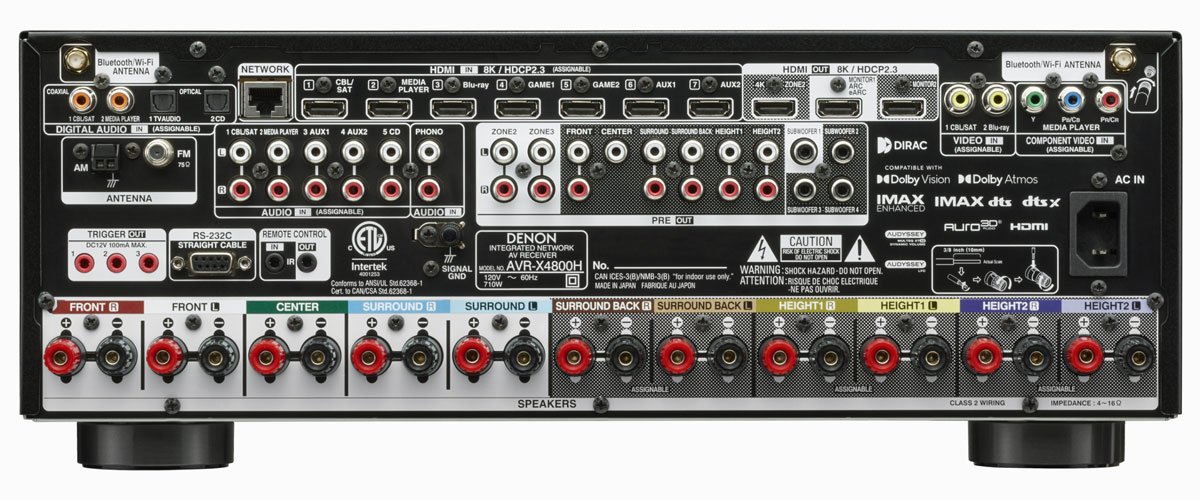
The AVR-X4800H is a 9.4 channel 8K compatible AV receiver. It delivers up to 125W of power per channel with 8-ohm speakers (20-20,000 Hz) at 0.05% THD. The device fully supports Dolby technologies, including the latest DTS Virtual:X and Auro-3D. An exciting moment is that the device has 4 amplified subwoofer outputs, creating an immersive and deep sound in several zones. According to the AVR-X4800H specifications, it supports Zone 3 features, creating up to 3 separate rooms and controlling them from a single unit.
The receiver has 7 HDMI inputs. Sadly, none of them is located on the front side. Also, on the rare side, there are 3 HDMI outputs. All HDMIs are 2.1 and can maintain 8K/60Hz AB or 4K/120Hz AB. Inputs and outputs come with 2.3 HDCP technology. The device has 5 analog inputs, single phono, 2 digital optical and coaxial connectors, an assignable bi-amp drive, and an FM/AM antenna. Network capabilities are presented by fully supporting modern streaming services such as Amazon Alexa, Apple Airplay, etc., 2,5/5Ghz WI-FI, and Bluetooth. Altogether, a substantial number of ports and connectors.
The Denon AVR-X4800H features the latest video technologies. As I have noticed, it showed an outstanding capability with 4K/120hz video and 8K upscaling. The list of other video features includes support for Dolby Vision, HDR10+, and those that came before it, Dynamic HDR. In addition, it allowed me to watch action movies seamlessly, without a single stutter or lag. Speaking about gaming, if you have a compatible console or PC, you can play at 4k 120 frames per second with no problems, thanks to the support of VRR, ALLM, and Quick Frame Transport.
The Smart TV connectivity feature was another aspect that took my attention. With all my respect to the Denon remote, I am more used to my TV one. This feature allowed me to control the receiver connected to my Philips 8K TV via HDMI. Very convenient, especially for those who don't want to manage multiple remotes.
Listening experience

I began my sound test with a rather unusual thing - listening to music. Indeed, one won't buy an AV receiver solely to listen to music, but this is still one of the typical use cases. The AVR- X4800H offers several sound modes. You can conveniently switch between those via the remote or app. Although some sound modes may be somewhat distinct from the original tracks, I made them more vibrant with a phasing effect. Yet, none of the sound modes can fix low-quality songs. Altogether, the unit proved itself to be an improvement over the AVR- X4700H, offering more detailed and broader sound with great detail.
When gaming, the receiver incredibly precisely worked with object-based sounds. In movies, the AVR-X4800H doesn't have the same power as Yamaha RX-A6A but provides a more transparent and precise sound. The truth is that in terms of power, the new model is not much of an improvement over the X4800H. Yet, it surpassed its predecessor in terms of immersive sound and dynamics. The new AVR-X4800H is an excellent and reliable receiver with no game-changing flaws that may spoil the experience.
Key specs
- Channels: 9.4.
- Power output: 125W/8 Ohm, 165W/6 Ohm.
- HDMI inputs/outputs: 7/3.
- Video functions: 8K/60Hz, 4K/120Hz, 4K/60Hz pass-through, video upconversion (up to 1080p and 8K) for analog and HDMI sources.
- Bluetooth/Wi-Fi: yes/yes.
- Streaming services: AirPlay2, Deezer, Tidal, Pandora, SiriusXM, Napster, SoundCloud, Amazon Music, Amazon Music HD, Mood mix.
- Supports: HDMI ARC, HDMI eARC, HDMI CEC, HDCP2.3, HDR10, HDR10+, Dolby Vision.
- Surround sound: DTS HD Master, DTS Neural:X, Dolby TrueHD, Dolby Surround, Dolby Digital Plus, Dolby Atmos Height Virtualization, Dolby Atmos, Auro-3D, IMAX Enhanced, Multichannel stereo.
Audiophiles and film fans should definitely like this multi-zone receiver. In addition to boasting full modern 3D audio support, the Denon AVR-X4800H also has excellent performance and a large number of HDMI ports that make it stand out from other competitors.
Yamaha RX-A6A
The receiver is the heart of the home theater system. Thanks to it, you can have an unforgettable experience and add some bright colors to watching movies and listening to music. Today, I have prepared a Yamaha RX-A6A review for you. In my opinion, this device is perfect for the most avid fans of high-quality sound.
The RX-A6A was created in 2021 and is the second model in the premium Aventage series. However, there is not much difference between it and the top flagship RX-A8A, and many of the same technologies are available here at a better price.
Design

Externally, all models of the Aventage series resemble each other, having a pleasant and minimalistic design. The RX-A6A has a glossy black panel with a vast built-in volume control in the center, an input select dial, and an LCD (which can be customized to show the information you want).
You won't find many connectors on the front panel. Such a solution preserves the neatness of the receiver. There is only a 6.3 mm headphone jack, a USB-A port, and a mini-jack for auto-calibration. Audio noise has been reduced thanks to Anti Resonance Technology (A.R.T.) Wedge. Convenient, simple, and ergonomic. I like it.
Features and specs

The receiver has a 9.2 channel amplifier with 150 watts per channel (8 ohms, 20Hz - 20kHz, 0.06% THD, 2ch driven). Also, the Yamaha Aventage RX-A6A features a 32-bit SABRE PRO Premier ES9026PRO DAC (main channels) and an ES9007S (height channels).
As for the video capabilities of the model, it supports 8K resolution, last HDR formats, and enhanced gaming. After the testing, I was pleased with the result. The picture was at the highest level, as the movie scenes looked bright and clear. I especially liked the detailing of the individual elements. Due to this, my eyes were not tired after the prolonged viewing.
Also, it presents a fairly wide range of possibilities when it comes to the specifications of the RX-A6A and connection options. It has 7 HDMI inputs and 3 HDMI outputs with HDCP 2.3 and eARC support. By the way, all these ports have HDMI 2.1 with up to 40 Gbps bandwidth. Connection methods include 2 subwoofer outputs, Wi-Fi, Bluetooth, USB port, Phono (MM) input, and so on. Basically, it has everything a modern receiver should have. Therefore, I give another plus to this model.
RX-A6A supports the latest surround sound formats, such as Dolby Atmos, Auro-3D, and DTS:X with CINEMA DSP HD3. Agree that such a set immediately indicates that watching a movie will now become a whole new level of quality. Definitely, it's a plus.
The advantage of this device is also the ability to easily and quickly play music from different streaming services through the MusicCast App. And I have to say, there are many of them, including Spotify, Pandora, Tidal, and others. As for iPhone owners, they will like the presence of AirPlay 2 technology. Convenient features also include the presence of three multi-room zones, which is quite rare (mostly, there is support for 2 zones) in mid-range models.
Despite the excellent hardware and a wide range of features, the small and poorly readable display frustrated me a bit. Obviously, Yamaha sacrificed screen size in favor of a minimalistic and beautiful panel.
Listening experience
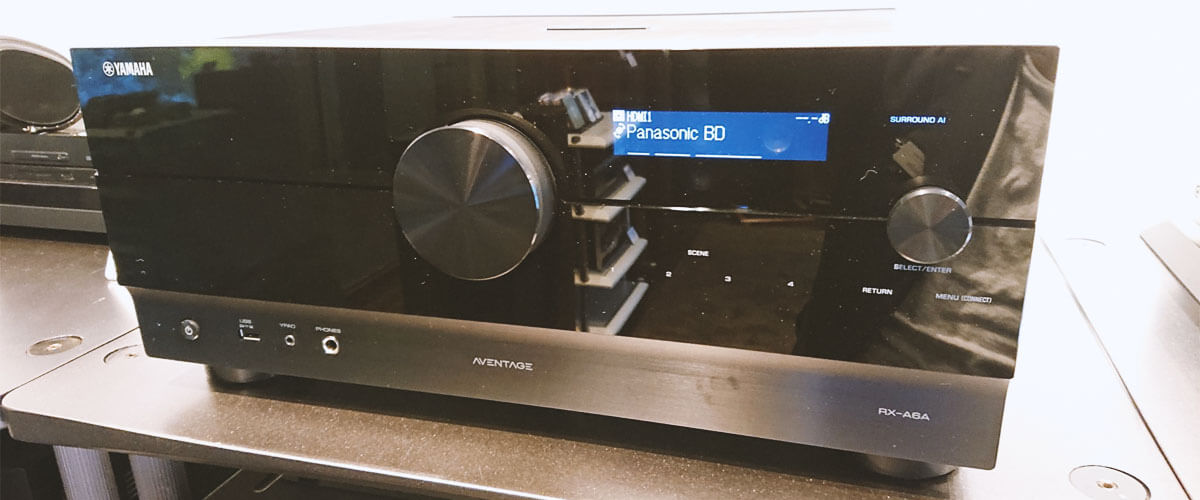
Now let's talk directly about my testing experience. For starters, I calibrated the sound with the YPAO-R.S.C. Although the sound improved, Denon and Marantz have already switched to the more advanced Dirac Live. The setting options are more advanced there, although YPAO is quite able to cope with its task.
The two-channel mode is neutral without adding the typical Yamaha warmth. I did not like Surround:AI because it distracted me by turning on and off the reverb effect in songs where there are vocals and instruments.
As for the surround sound, it was top-notch! The dialogues were heard clearly and perceived in a completely new way. In addition, the action scenes made me shudder and relive everything together with the hero. In a word - great!
Key specs
- Channels: 9.2.
- Power output: 150W/8 Ohm.
- HDMI inputs/outputs: 7/3.
- Video functions: 8K/60Hz, 4K/120Hz, 4K/60Hz pass-through, video upconversion (up to 1080p and 8K) for analog and HDMI sources.
- Bluetooth/Wi-Fi: yes/yes.
- Streaming services: AirPlay2, Deezer, Tidal, Pandora, SiriusXM, Napster, SoundCloud, Amazon Music, Amazon Music HD, Mood mix.
- Supports: HDMI ARC, HDMI eARC, HDMI CEC, HDCP2.3, HDR10, HDR10+, Dolby Vision.
- Surround sound: DTS HD Master, DTS Neural:X, Dolby TrueHD, Dolby Surround, Dolby Digital Plus, Dolby Atmos Height Virtualization, Dolby Atmos, Auro-3D
In short, the Yamaha RX-A6A copes perfectly with all the assigned tasks. This is exactly the case when the model is good at everything. Of course, you can always complain about something, but that doesn’t change the fact that it is one of the most successful Yamaha receivers of the last few years.
FAQ
How to build a multi-room sound system?
Let’s look at an example of a 9-channel receiver with 3 zones, which are absolutely all of the models in my review. In order to watch or listen to different content independently, you must connect your home devices with an HDMI cable to different receiver zones. It would be perfect if placing the wires were provided even at the stage of repair. This will save some space in the room. As you can see, there is nothing complicated.
How many zones can a receiver have?
Recently, companies have followed the trend of “the more – the better.” But that doesn’t mean that a receiver with many zones will do you any good in a one-room apartment. So, it would help if you always started with your real needs first.
We are supported by our audience. When you purchase through links on our site, we may earn an affiliate commission at no extra cost to you.
Our newsletter
* We will never send you spam or share your email with third parties

![Best Stereo Receivers [Reviewed and Tested]](https://mediapro-av.com/wp-content/uploads/2024/01/best-stereo-receiver-300x150.jpg)
